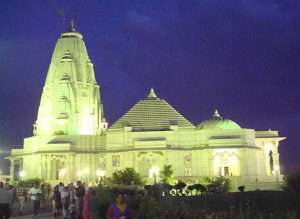 Campus has Laxmi Narayan Temple . It is situated in the college campus area.
Campus has Laxmi Narayan Temple . It is situated in the college campus area.
Laxmi Narayan Temple devoted to goddess Laxmi and god Vishnu. the temple is a proud landmark. The temple is made up of pure white marble with a modern approach and style. Both the idols of the deities are designed beautifully and look amazing. Inside the temple, other things can be found such as idols of other Hindu deities, ancient quotes, Hindu symbols, ornaments and many more on the walls of the temple.
Mythological events are also carved on some walls. Other than religious and godly images, pictures of philosophers, saints, historical achievers can also be found. The temple is a perfect example of modern day architecture blended with religious interiors. The temple has three domes to represent here religions of India. A lavish garden surrounds the temple.
The best attraction of the temple is the idol of Laxmi Narayan which was carved from a single stone. The interiors of the temple are done with beautiful paintings of Hindu deities. The steps of the temple are also made up of marble and the outside of the temple is equally beautiful as the interior of the temple.
Pedagogy of the Temple: PEACE and Liberation
 The learning that experienced while at the temple was deep and very effective. In less than a month it discovered skills, knowledge(s) and awareness that, six years later, If it regularly apply to daily life. It had powerful individual and group experiences that both pushed out students in comfort zone. These experiences drastically altered their perception, and subsequently their actions.
The learning that experienced while at the temple was deep and very effective. In less than a month it discovered skills, knowledge(s) and awareness that, six years later, If it regularly apply to daily life. It had powerful individual and group experiences that both pushed out students in comfort zone. These experiences drastically altered their perception, and subsequently their actions.
Althoug, the Pedagogy of the Temple is a secular approach that can be applied in most any environment, with learners of all ages. The Pedagogy of the Temple is a teaching pedagogy that encourages teaching and learning, which is Practical, Experiential, Altruistic, Constructivist, Ecological, and Liberatory. It is also known as The Pedagogy of PEACE and Liberation.
Spirituality means something different to everyone. For some, it’s about participating in organized religion: going to temple, church, synagogue, a mosque, and so on. For others, it’s more personal: Some people get in touch with their spiritual side through private prayer, yoga, meditation, quiet reflection, art, listening to music, writing poetry, reading or even long walks.
Spirituality may refer to almost any kind of meaningful activity, personal growth, or blissful experience.
After many researches and interacting with a lot of people who practices spirituality, It is the conclusion , spirituality in students’ play a great role in facilitating the development of students’ positive qualities.
Moreover, educational experiences and practices that promote spiritual development by exposing students to diverse people, cultures, and ideas through cross cultural studies, interdisciplinary coursework, service learning and other forms of civic engagement helps students value multiple perspectives as they confront the complex social, economic, and political problems of our time.
Meditation, contemplation and self-reflection are among the most powerful tools for enhancing and promoting students’ spiritual development.
